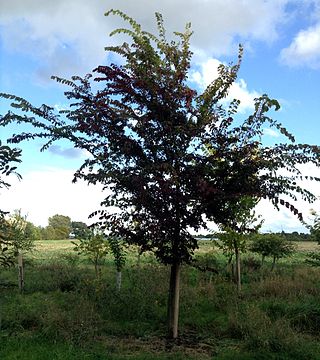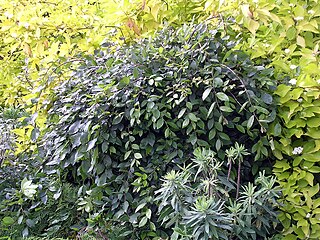Related Research Articles

Ulmus 'Frontier' is an American hybrid cultivar, a United States National Arboretum introduction derived from a crossing of the European Field Elm Ulmus minor with the Chinese Elm Ulmus parvifolia in 1971. Released in 1990, the tree is a rare example of the hybridization of spring- and autumn-flowering elms. Tested in the US National Elm Trial coordinated by Colorado State University, 'Frontier' averaged a survival rate of 74% after 10 years.

Ulmus 'Homestead' is an American hybrid elm cultivar raised by Alden Townsend of the United States National Arboretum at the Nursery Crops Laboratory in Delaware, Ohio. The cultivar arose from a 1970 crossing of the Siberian Elm Ulmus pumila with the hybrid N 215, the latter grown from seed sent in 1960 to the University of Wisconsin-Madison elm breeding team by Hans Heybroek of the De Dorschkamp Research Institute in the Netherlands. Tested in the US National Elm Trial coordinated by Colorado State University, 'Homestead' averaged a survival rate of 85% after 10 years in the US National Elm Trial. However, planting of the tree was not recommended, owing principally to its 'ugly' shape and susceptibility to Southwest injury. 'Homestead' was released to commerce without patent restrictions in 1984.

The hybrid elm cultivar Ulmus × hollandica 'Pioneer' is an American clone arising from the crossing of two European species, Wych Elm U. glabra and Field Elm U. minor. Raised by the USDA station at Delaware, Ohio, in 1971, 'Pioneer' was released to commerce in 1983.

Ulmus 'Morton Glossy' is a hybrid cultivar raised by the Morton Arboretum, Illinois. Originally named 'Charisma' until it was realized that name had already been registered for another plant, the tree was derived from a crossing of two other hybrid cultivars grown at the Morton: Accolade and Vanguard. Tested in the US National Elm Trial coordinated by Colorado State University, Triumph averaged a survival rate of 86% after 10 years. Triumph was introduced to the UK in 2006 by the Frank P. Matthews nursery in Worcestershire.
Ulmus 'Morton Plainsman' is a hybrid cultivar raised by the Morton Arboretum from a crossing of Siberian Elm and a Japanese Elm grown from openly pollinated seed donated by the Agriculture Canada Research Station at Morden, Manitoba. Tested in the US National Elm Trial coordinated by Colorado State University, Vanguard averaged a survival rate of 78% after 10 years.

The American elm cultivar Ulmus americana 'New Harmony' was raised by the Maryland Agricultural Research Service and released by the United States National Arboretum in 1995, along with 'Valley Forge'. 'New Harmony' proved the most successful U. americana cultivar in the US National Elm Trial, averaging a survival rate of 85.5% overall.

Ulmus parvifolia 'UPMTF' is a Chinese Elm cultivar that was found in a field at Moon's Tree Farm, Atlanta, Georgia, in 1993 and raised by Moon's Tree Farm nursery. It was patented in 2000. It is notable for its upright ascending branches.

Ulmus parvifolia 'Emer II' or 'Emerald Vase' is a Chinese Elm cultivar selected by Dr. Michael A. Dirr and cloned in the late 1980s from a tree planted circa 1910 on the University of Georgia campus at Athens, that had survived ice-storms undamaged. It was patented in 1991.
The Chinese Elm cultivar Ulmus parvifolia 'Emer I' or 'Emerald Isle' was cloned from a tree planted circa 1920 on the University of Georgia campus at Athens.

Ulmus parvifolia 'A. Ross Central Park' is a Chinese elm cultivar that is probably the hardiest in cultivation and was patented in 1989 by David F. Karnosky. The original tree, planted in 1865 by James Hogg, grew near the entrance to Central Park, at the junction of Fifth Avenue and 72nd Street in the Upper East Side of Manhattan in New York City, and died in the 1990s aged over 120 years. The cloning project was initiated in 1976 by the Arthur Ross Foundation, and executed by the School of Forestry and Wood Products, Michigan Technological University, Houghton.

The Chinese Elm cultivar Ulmus parvifolia 'Drake' was marketed by the Monrovia Nursery of Azusa, California, first appearing in their 1952–1953 catalogue.
The Chinese Elm cultivar Ulmus parvifolia 'Dynasty' is a United States National Arboretum introduction resulting from a controlled crossing of two trees of Korean origin. First described in 1984, it is reputed to be very fast-growing.
The Chinese Elm cultivar Ulmus parvifolia 'Hallelujah' is one of three American introductions made circa 1992 that were selected for their cold hardiness. 'Hallelujah' is known to have withstood -37 °C (-35 °F) in Missouri. The tree was first listed by the Arborvillage Nursery, Holt, Missouri, in its 1993–1994 catalogue.
The Chinese Elm cultivar Ulmus parvifolia 'Pathfinder' was raised by A. M. Townsend of the USDA National Arboretum and registered in 1990.

The Chinese Elm cultivar Ulmus parvifolia 'Sempervirens' is an American introduction from south China, commonly known by the synonym 'Evergreen'. It was first listed by Bailey & Bailey in Hortus Second, 747, 1941.
Ulmus davidianavar.japonica 'JFS-Bieberich' is a Japanese Elm cultivar that was raised by the Sunshine Nursery, Oklahoma, from seed collected in China by proprietor Steve Bieberich. Emerald Sunshine proved only moderately successful in the US National Elm Trial, averaging a survival rate of 70% overall.

Ulmus 'Patriot' is a hybrid cultivar raised by the United States National Arboretum in 1980. Derived from a crossing of the American hybrid 'Urban' with the Wilson's Elm cultivar 'Prospector', 'Patriot' was released to commerce, free of patent restrictions, in 1993. Tested in the US National Elm Trial coordinated by Colorado State University, 'Patriot' averaged a survival rate of 85% after 10 years.

The winged elm cultivar Ulmus alata 'Lace Parasol' was found by a North Carolina nurseryman growing in local woods. Removed to his yard, it remained there until his death, when it was removed again to the North Carolina State Arboretum in Raleigh by J. C. Raulston.
The Chinese Elm cultivar Ulmus parvifolia 'Elsmo' was released by the USDA Soil Conservation Service, at Elsberry, Missouri, in 1990 as an open-pollinated, seed-propagated cultivar of extremely variable progeny.
The Chinese Elm cultivar Ulmus parvifolia 'Garden City Clone' was raised in Kansas. The champion tree was 18 m tall in 1993; however, the name 'Garden City Clone' is not officially recognized.
References
- ↑ M.A. Dirr, Manual of Woody Landscape Plants, Ed. 4, Stipes Publ. Co., Champaign, Illinois, 1990, p. 878
- 1 2 Santamour, Frank S.; Bentz, Susan E. (May 1995). "Updated Checklist of Elm (Ulmus) Cultivars for use in North America". Journal of Arboriculture. 21 (3): 122–131. Retrieved 20 June 2016.
- ↑ "Elm Leaf Beetle Survey". Archived from the original on 2011-07-19. Retrieved 17 July 2017.
- ↑ U. parvifolia 'Burgundy', Dawes Arboretum; dawesarb.arboretumexplorer